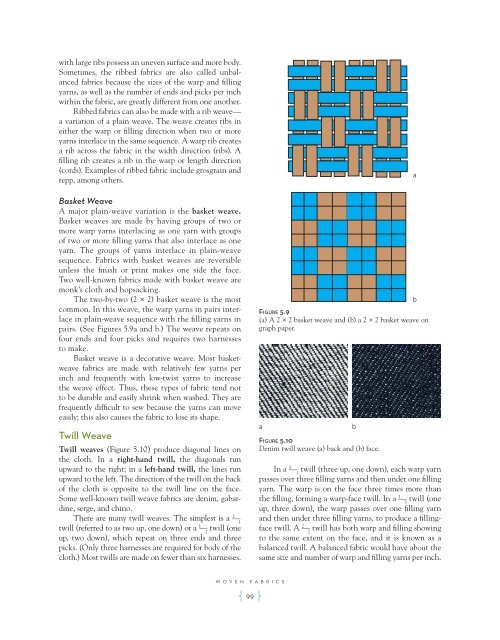Create successful ePaper yourself
Turn your PDF publications into a flip-book with our unique Google optimized e-Paper software.
with large ribs possess an uneven surface and more body.<br />
Sometimes, the ribbed fabrics are also called unbalanced<br />
fabrics because the sizes of the warp and filling<br />
yarns, as well as the number of ends and picks per inch<br />
within the fabric, are greatly different from one another.<br />
Ribbed fabrics can also be made with a rib weave—<br />
a variation of a plain weave. The weave creates ribs in<br />
either the warp or filling direction when two or more<br />
yarns interlace in the same sequence. A warp rib creates<br />
a rib across the fabric in the width direction (ribs). A<br />
filling rib creates a rib in the warp or length direction<br />
(cords). Examples of ribbed fabric include grosgrain and<br />
repp, among others.<br />
Basket Weave<br />
A major plain-weave variation is the basket weave.<br />
Basket weaves are made by having groups of two or<br />
more warp yarns interlacing as one yarn with groups<br />
of two or more filling yarns that also interlace as one<br />
yarn. The groups of yarns interlace in plain-weave<br />
sequence. <strong>Fabrics</strong> with basket weaves are reversible<br />
unless the finish or print makes one side the face.<br />
Two well-known fabrics made with basket weave are<br />
monk’s cloth and hopsacking.<br />
The two-by-two (2 × 2) basket weave is the most<br />
common. In this weave, the warp yarns in pairs interlace<br />
in plain-weave sequence with the filling yarns in<br />
pairs. (See Figures 5.9a and b.) The weave repeats on<br />
four ends and four picks and requires two harnesses<br />
to make.<br />
Basket weave is a decorative weave. Most basketweave<br />
fabrics are made with relatively few yarns per<br />
inch and frequently with low-twist yarns to increase<br />
the weave effect. Thus, these types of fabric tend not<br />
to be durable and easily shrink when washed. They are<br />
frequently difficult to sew because the yarns can move<br />
easily; this also causes the fabric to lose its shape.<br />
Twill Weave<br />
Twill weaves (Figure 5.10) produce diagonal lines on<br />
the cloth. In a right-hand twill, the diagonals run<br />
upward to the right; in a left-hand twill, the lines run<br />
upward to the left. The direction of the twill on the back<br />
of the cloth is opposite to the twill line on the face.<br />
Some well-known twill weave fabrics are denim, gabardine,<br />
serge, and chino.<br />
There are many twill weaves. The simplest is a 2 — 1<br />
twill (referred to as two up, one down) or a 1 — 2 twill (one<br />
up, two down), which repeat on three ends and three<br />
picks. (Only three harnesses are required for body of the<br />
cloth.) Most twills are made on fewer than six harnesses.<br />
WOVEN FABRICS<br />
A 99 F<br />
Figure 5.9<br />
(a) A 2 × 2 basket weave and (b) a 2 × 2 basket weave on<br />
graph paper.<br />
b<br />
a b<br />
Figure 5.10<br />
Denim twill weave (a) back and (b) face.<br />
In a 3 — 1 twill (three up, one down), each warp yarn<br />
passes over three filling yarns and then under one filling<br />
yarn. The warp is on the face three times more than<br />
the filling, forming a warp-face twill. In a 1 — 3 twill (one<br />
up, three down), the warp passes over one filling yarn<br />
and then under three filling yarns, to produce a fillingface<br />
twill. A 2 — 2 twill has both warp and filling showing<br />
to the same extent on the face, and it is known as a<br />
balanced twill. A balanced fabric would have about the<br />
same size and number of warp and filling yarns per inch.<br />
a<br />
a<br />
b













